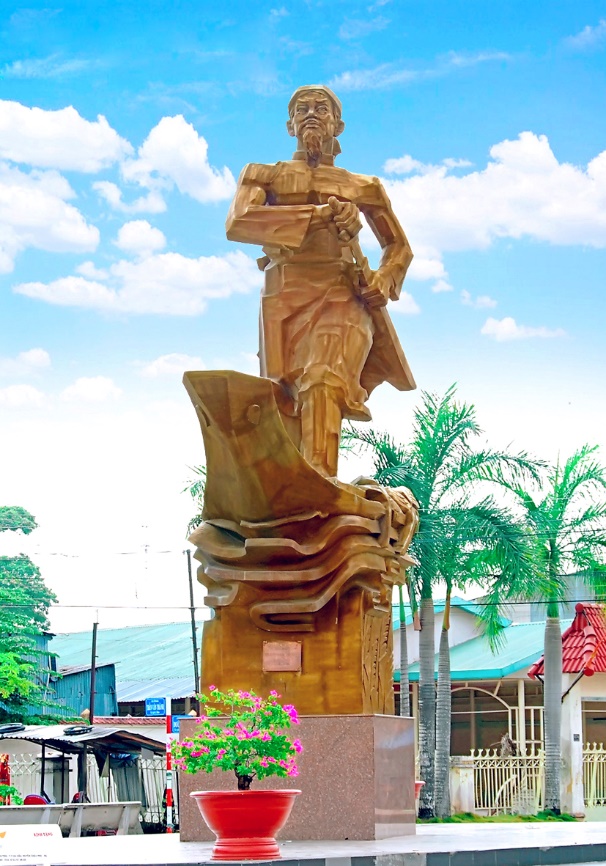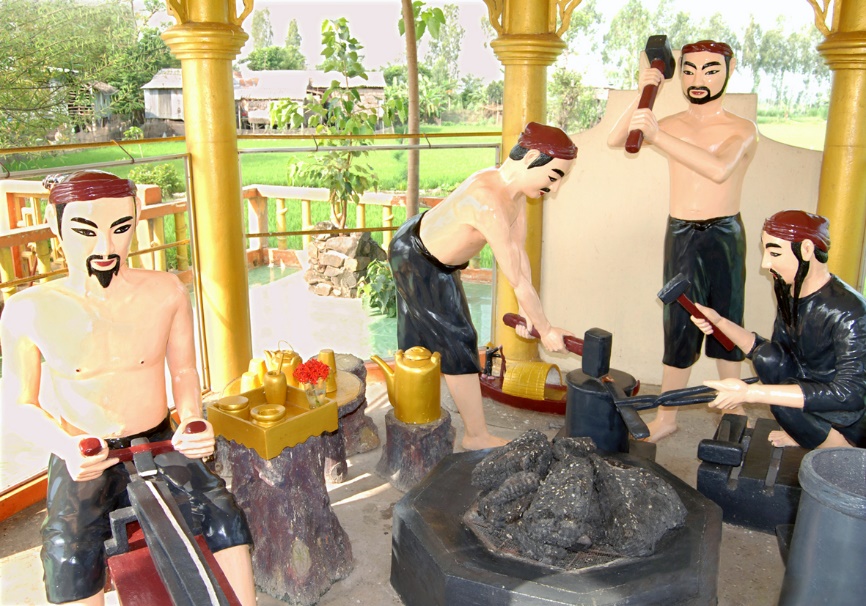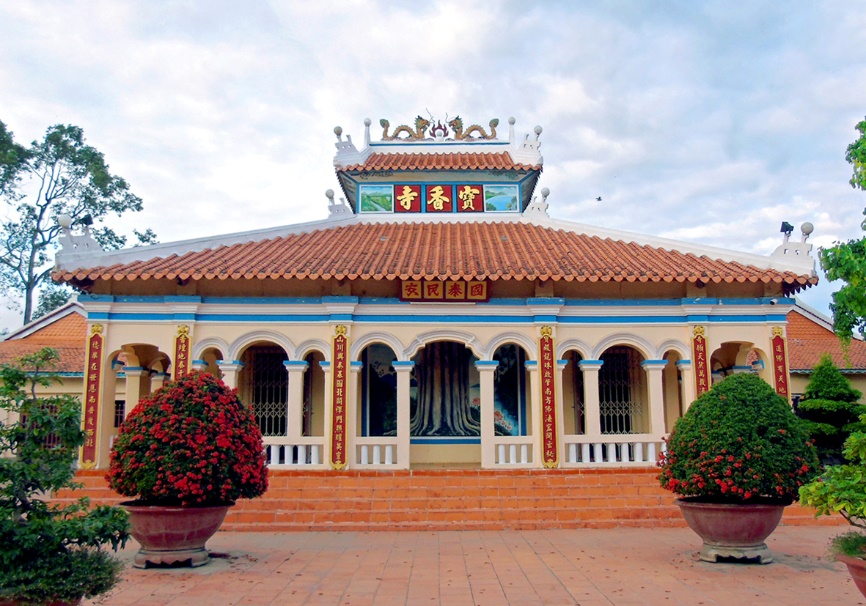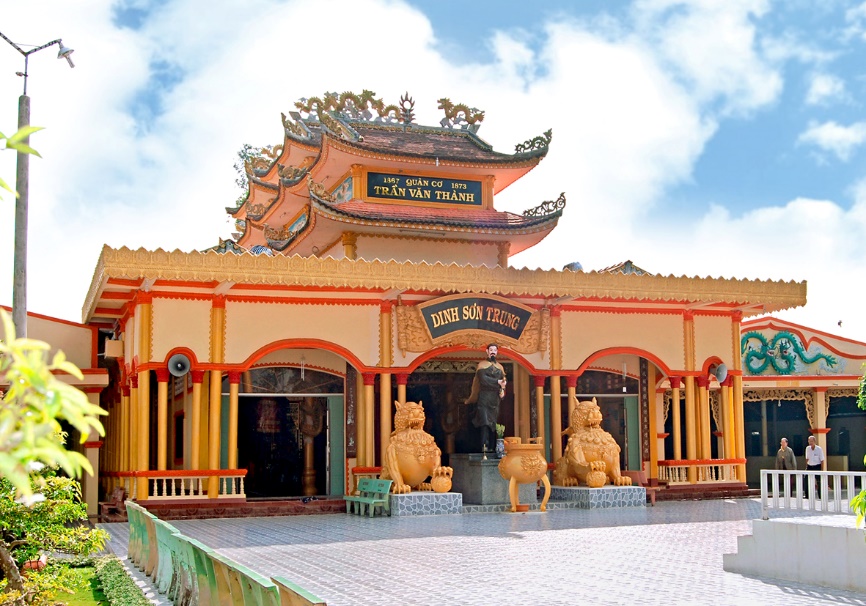Chau Phu and Chau Thanh are two agricultural districts in the province of An Giang with expansive fields. However, this location is also associated with the Lang Linh - Bay Thua uprising led by Mr. Tran Van Thanh against the French of Gia Nghi insurgent soldiers. These two districts still contain numerous remnants of the rebellion. On the 21st day of the second lunar month, people in the region solemnly commemorate the day the insurgent was subdued, an event that occurred 150 years ago (1873 - 2023).

Statue of Manager Tran Van Thanh
Lang Linh field and Bay Thua forest are large alum lowland regions in the districts of Chau Phu and Chau Thanh. The ancients designated this location as "ne dia." In other words, the terrain was swampy, wet, and flooded... Due to the fact that this land was almost entirely submerged during the flood season. In the dry season, vast, impassable reed fields appeared among stagnant water.
The Lang Linh - Bay Thua uprising was a large-scale anti-French movement of Gia Nghi insurgents led by Tran Van Thanh. Mr. Tran Van Thanh was born approximately in 1820 in Binh Thanh Dong village, Vinh Trinh canton, Vinh An district, Dinh Vien district, Vinh Thanh town (currently Phu Binh commune, Phu Tan district, An Giang province). In his youth, he served in the Nguyen Dynasty's army, earned many accolades, and was promoted to Chief of Staff. After that, he took refuge with Buddha Master Tay An (Doan Minh Huyen, 1807 - 1856) and became one of the great disciples of Buu Son Ky Huong. His master tasked him with reclaiming the Lang Linh region and establishing a farm named Buu Huong Cac.
In 1867, when the French occupied An Giang, he recruited an insurgent army named Gia Nghi to fight the French. The uprising's headquarters was the Hung Trung garrison, which was surrounded by numerous small forts with strong defenses. They created their own weapons and firearms and obtained food from the populace. Many battles were won by the insurgents, causing great confusion in France. Numerous French attempts to infiltrate the base failed due to their unfamiliarity with the muddy terrain. They sent letters to Tran Van Thanh to entice him to surrender, but he was determined not to do so.

The model of the Bay Thua Forge
Early in 1873, the French orchestrated a massive sweep into the base, assaulted it from three sides, and then penetrated Hung Trung's headquarters. Gia Nghi's troops fought stubbornly even though they were under a lot of pressure from the enemy. However, their small numbers and lack of modern weapons led to their defeat. According to legend, Tran Van Thanh and a few of his remaining soldiers escaped deep into the That Son region, after which no one knew where they were. In the year 1873, it was the 21st day of the second lunar month.
Later generations described the indomitable spirit of Gia Nghi insurgent soldier with the phrase, "It is better to lose than to surrender to the enemy." The people of An Giang refer to Tran Van Thanh with the honorific "Duc Co Quan." The Duc Co Quan festival is held annually from the twentieth to the twenty-second day of the second lunar month, attracting tens of thousands of people from around the globe. Since 2003, the Duc Co Quan festival has been designated as the district of Chau Phu's traditional cultural celebration.

Buu Huong Pagoda
Buu Huong Pagoda, also known as Duc Co Palace, in Thanh My Tay commune (Chau Phu district), is the most significant cultural historical relic associated with the Bay Thua uprising.
The relic is located on a sprawling campus, in front of a large lotus pond that is surrounded by numerous luxuriant ancient trees. The structure has a simple design, a harmonious layout, and a traditional Southern style. The interior is a space with ethnic personality, majesty, and intimacy, as it has both the appearance of a temple and the characteristics of an old Southern home. The main hall venerates Lord Buddha in front of Tay An and Duc Co Quan in the rear; in addition, there are numerous altars for martyrs of the uprising and devotees of the deceased national...
This is the land that Tran Van Thanh's family and Buu Son Ky Huong's followers have reclaimed to establish the Buu Huong Cac farm. After the failed uprising, his wife and children fled to this area of the land to conceal themselves. Tran Van Nhu, the eldest son of Tran Van Thanh, constructed the Buu Huong Pagoda in the early twentieth century. During that time, the pagoda appeared to be a place of Buddhist worship, but it was actually a memorial to Gia Nghi soldiers.
In 1913, when the Vietnamese clandestinely celebrated Duc Co Quan's birthday, the French army was informed that they had been surrounded and burned. Later, the locals repeatedly reconstructed the pagoda on its original foundation, but the French also led to repeated persecution. People joined forces in 1952 to rebuild the expansive temple, but it was not until 1997 that the decoration was completed in its current form. Not far from Buu Huong is the temple of Duc Co Quan's wife, Mrs. Nguyen Thi Thanh. She was responsible, along with her husband, for opening the Lang Linh region and supplying the resistance with insurgents.

Son Trung Palace
Equally renowned is the Son Trung palace in Vinh An commune (Chau Thanh district), where Gia Nghi insurgents manufacture their weapons. To honor the remains of their ancestors, people initially erected a bamboo-and-leaf temple on a high mound. In the early 1950s, the temple was built, and after many restorations, it became a temple massive project.
Son Trung palace has a dignified, modern, and ornate appearance from the exterior inward. Many old houses overlapping on many floors (along the vertical axis) and many layers (along the horizontal axis) create a new architectural style. The interior of the palace is exquisitely embellished with intricately carved and gold-painted worship objects in ancient style, such as dignified altars, ancient altar beds, successful sacks, etc., all of which are intricately carved and painted. In addition to being a place of worship for Duc Co Quan and the insurgent army, the main hall houses many artifacts from this land, such as swords, copper trays, dishes, etc.
Behind the main hall, the replica of the Bay Thua forge was reconstructed with a cement statue to serve as a memorial and accommodate visitors' needs. The image of soldiers in the past diligently forging weapons to aid in the fight against foreign invaders is reproduced in a straightforward yet vivid manner. The entire relic is located on a campus that is cool, quiet, and filled with fresh air.
In addition, in the heart of Cai Dau, the district capital of Chau Phu district, is Tran Van Thanh Park, which features a statue of Manager Tran Van Thanh. The statue is 15 meters tall, stands in the middle of a lot of space, and was made by Tran Thanh Phong in 2003. The figure depicts Mr. Tran Van Thanh standing majestically on a canoe riding the waves, with his face turned towards Lang Linh and a sword in his hand as if he is about to charge into battle.
Author: Yen Luong - Translator: Kim Thuan